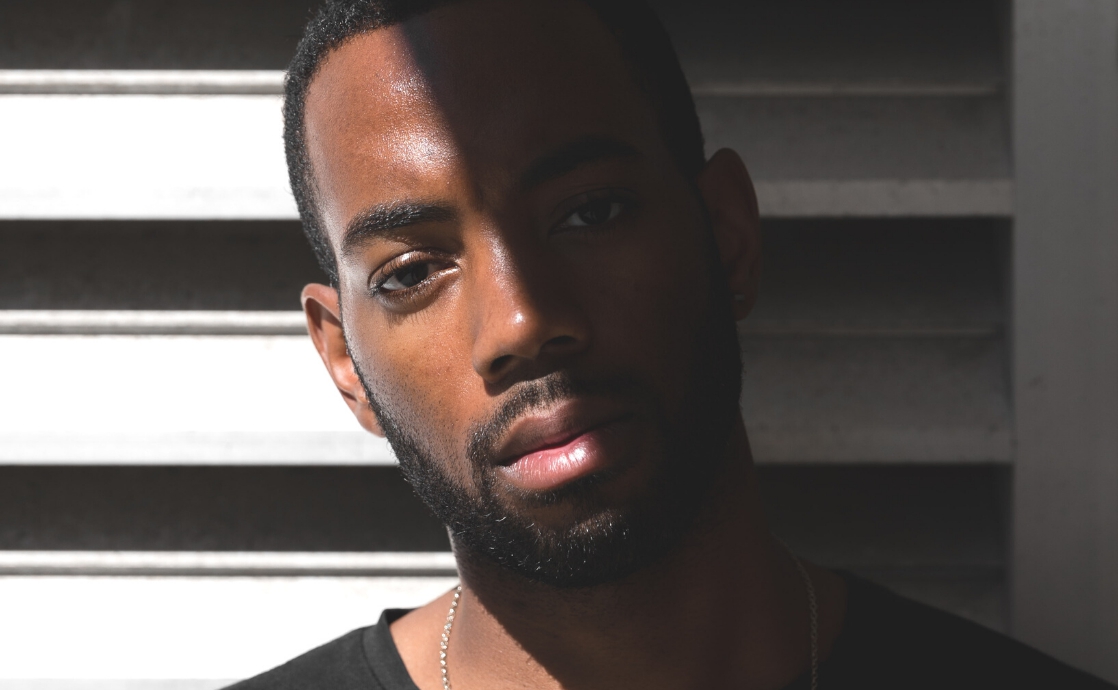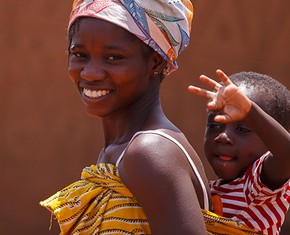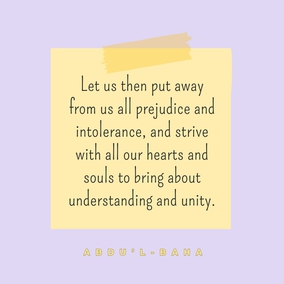The views expressed in our content reflect individual perspectives and do not represent the authoritative views of the Baha'i Faith.
When I was in grade school, I was taught that “black” represented the absence of color — a void of “nothingness” into which all things were consumed and divested of their distinguishing characteristics. On the other hand, “white” was designated as the point of reflection, the epicenter of color where all reality is made visible.
My training in art revealed that the gradations of black are created by the gradual mixing of all colors, indicating the presence of reality and not its absence. But, as a child, with no historical context to draw from, no deepened awareness of the function of blackness in the phenomenal world, and no understanding of how language shapes thought, I accepted this reasoning without question. I was unaware that in my developing mind, this diminished the value of “blackness” and inflated the estimation of “whiteness.”
It would be years before I began to realize the paradoxical relationship between black and white, light and dark, that represented a false dichotomy — a racial construct of convenience meant to reinforce superficial divisions, to reinforce and consolidate oppressive power.
I became a Baha’i in 1992, and the healing message of Baha’u’llah, the prophet and founder of the Baha’i Faith, was a balm to my soul. I often reflect on the words of Abdu’l-Baha, his son and one of the central figures in the Baha’i Faith:
Bahá’u’lláh rose like a shining star from the horizon of Persia, inspired with the message of Peace and of Brotherhood among men. He brought the light of guidance to the world; He kindled the fire of love and revealed the great reality of the True Beloved. He sought to destroy the foundations of religious and racial prejudice and of political rivalry. He likened the world of humanity to a tree, and all the nations to its branches and the people to its leaves, buds and fruits.
The centering of unity, truth, and justice by Baha’u’llah compels me to prayerfully deconstruct how the concept of “blackness” lives within the collective consciousness of America — giving rise to the vilification, objectification, and dehumanization associated with the Black body.
This endeavor has formulated a radical reimagining of “Black identity” predicated on the teachings of the Baha’i Faith, which disrupts the pervasive evils of racial hierarchies.
RELATED: Why Discomfort Is a Sign of Racial Healing
The Baha’i writings reposition people of African descent from the nadir of the social order to the vanguard of the spiritual transformation of the human race — a result of the profound spiritual insight associated with Black people by Baha’u’llah himself. Indeed, Baha’u’llah compared people of African descent to the “black pupil of the eye” through which “the light of the spirit shineth forth.”
It is this revolutionary, spiritual vision — unique in the annals of religious history — that forms the spiritual and conceptual foundation for a New Black Liberation Theology within the framework of the Baha’i Faith. It embodies the best of 19th century African American minister Henry McNeal Turner who once said: “Lord have mercy on any race of people who do not believe that they look like GOD,” and the pioneering work of 20th century theologian James Cone, who coined the term “Black Liberation Theology” to link the struggle of Black people with Jesus Christ’s concern for the poor and the oppressed.
Baha’u’llah’s teachings on the spiritual distinction of people of African descent and their role in the evolution of humanity towards oneness extends the scope and reach of Black Liberation Theology by binding it, through the potency of his revelation, to the destiny of all humanity. And to grasp this point, I must consider a new understanding of “blackness,” one that reflects the unifying nature of its material and spiritual reality.
To wholeheartedly believe in this is not a manifesto of Black separatism, nor is it a polemic against the myth of American exceptionalism embodied in the enduring contradiction between the nation’s ideals and its fractured reality. Centering “blackness” is an inclusive reality and not a marginalizing one. But that impulse to believe otherwise is the result of the imposition of white privilege, which requires non-white populations to defend the case for the foregrounding of their narratives in public spaces. “Whiteness” makes no such demands of itself. It is the only validation it needs.
The study of words, the concepts they imply, and how that relationship creates meaning and shapes our unconscious thought, is the basis of semiotics: a branch of linguistics pioneered by the 17th century English philosopher John Locke. A word operates as a “sign” that “signifies’’ —an associative meaning defined by the societal forces that determine the relationship. For example, blue is to the ocean, and as apple is to the tree. These relationships, once fixed, become the scaffolding for a collective conceptual framework, the contours of which shape the way we see the world.
Words have power precisely because of their capacity to affect the architecture of perception. The schoolyard rhyme “Sticks and stones may break my bones, but words can never hurt me” emerged as a psychological defense against the destructive forces of verbal bullying. Were it not for the acknowledged power of words, the existence of this lyrical countermeasure would be unnecessary. The ubiquitous representation of the words “colored” and “white” during the era of segregation to regulate social interaction, and maintain the unequal distribution of resources, is convincing evidence of the subversive capacity of language to govern expectations and temper ambition.
In his brilliant statement on the “semantics of black and white” the Rev. Dr. Martin Luther King Jr. commented on the perverse ability of the English language to reinforce and perpetuate racial hierarchies:
Even semantics have conspired to make that which is black seem ugly and degrading. In Roget’s Thesaurus there are 120 synonyms for blackness and at least sixty of them are offensive, as for example, blot, soot, grim, devil and foul. And there are some 134 synonyms for whiteness and all are favorable, expressed in such words as purity, cleanliness, chastity and innocence. A white lie is better than a black lie. The most degenerate member of a family is a “black sheep.” Ossie Davis has suggested that maybe the English language should be reconstructed so that teachers will not be forced to teach the Negro child sixty ways to despise himself, and thereby perpetuate his false sense of inferiority, and the white child 134 ways to adore himself, and thereby perpetuate his false sense of superiority.
Dr. King’s compelling example demonstrates that racist ideation is stitched into the very language that Americans speak, creating an enduring, subversive mix of pejorative tropes — denigrating connotations masquerading as benign colloquial expressions that exert a corrosive influence on how the objectified “other” is perceived. Fortunately for us, God has given humanity a divine “inhibitor” whose teachings have the capacity to arrest the rust of ignorance and burnish human consciousness with an inclusive understanding of “blackness” and its intrinsic relationship to “whiteness.”
According to Baha’u’llah, the prophet and founder of the Baha’i Faith:
…every created thing is a sign of the revelation of God. Each, according to its capacity, is, and will ever remain, a token of the Almighty. Inasmuch as He, the sovereign Lord of all, has willed to reveal His sovereignty in the kingdom of names and attributes, each and every created thing hath, through the act of the Divine Will, been made a sign of His glory.
In this construct, all phenomenal reality reflects and signifies spiritual reality. The physical world is brought into existence through the divine will and, as a result, bears the mark of the Creator. The relationship is complimentary, not adversarial.
This understanding impinges upon the tendency to internalize false dichotomies. It is a disruption of fragmentation, and an assertive declaration of integration. It is an affirmation that all creation, generated from one source, is interrelated.
When viewed through this lens, we see that the true nature of the phenomenal world is embodied in its interdependence. Careful observation confirms this reality; life begins in the darkness of the mother’s womb yet the child is born into the light — when the physical body dies, it is deposited into the loam of the earth, yet the eternal soul enters the light of reunion with the Creator. Indeed, Baha’u’llah states the purpose of this physical life is to prepare our souls for the spiritual, eternal life.
RELATED: Committing to Race Unity — Even When Times Get Scary
Though we live and work in the light, dreams are born in darkness — the scintillating brilliance of the stars are bound together in the fathomless depths of the black universe: The black pupil of the eye, the metaphor which Baha’u’llah used to describe people of African descent, is the point at which light enters and the faculty of sight is actualized.
Despite the presumption of innate inequality between black and white codified within the English language, Baha’u’llah writes of the Divine orientation characterized by an inherent mutuality expressed in the physical and the spiritual worlds. The mystical intercourse of light and dark, the one leading into the other, redefines the nature of the relationship.
The Baha’i Writings move the reality of “blackness” from the periphery — where it has been forced to dwell in a society framed by white supremacy — to the center, where all the colors folded within it — a symbolic representation of humanity — assume a co-equal position.
Therefore, a New Black Liberation Theology within the framework of the Baha’i Faith may be considered as a spiritual perception that unapologetically asserts Baha’u’llah’s vision of people of African descent and tethers that reality to the destiny of all humanity. In response to the unity of phenomenal and spiritual reality, it actively seeks to decenter the oppressive influence of the white gaze and reposition it as one of many equally relevant perspectives.
Inspired by the writings of Abdu’l-Baha, who said, “…we must be the servants of the poor, helpers of the poor, remember the sorrows of the poor, associate with them; for thereby we may inherit the Kingdom of heaven, “ this new liberation theology must center the needs of the downtrodden and the oppressed, a central concern in theologian James Cone’s original formulation of Black Liberation Theology.
And finally, compelled by the unifying words of Baha’u’llah himself:
O Son of Man! Veiled in My immemorial being and in the ancient eternity of My essence, I knew My love for thee; therefore I created thee, have engraved on thee Mine image and revealed to thee My beauty.
A New Black Liberation theology in the framework of the Baha’i Faith seeks to cultivate a vision, purified by the love of the Spirit, that recognizes the likeness of the Creator, within all creation so that we all may claim that “Yes indeed, I do look like GOD.”
















Comments
Sign in or create an account
Continue with Googleor